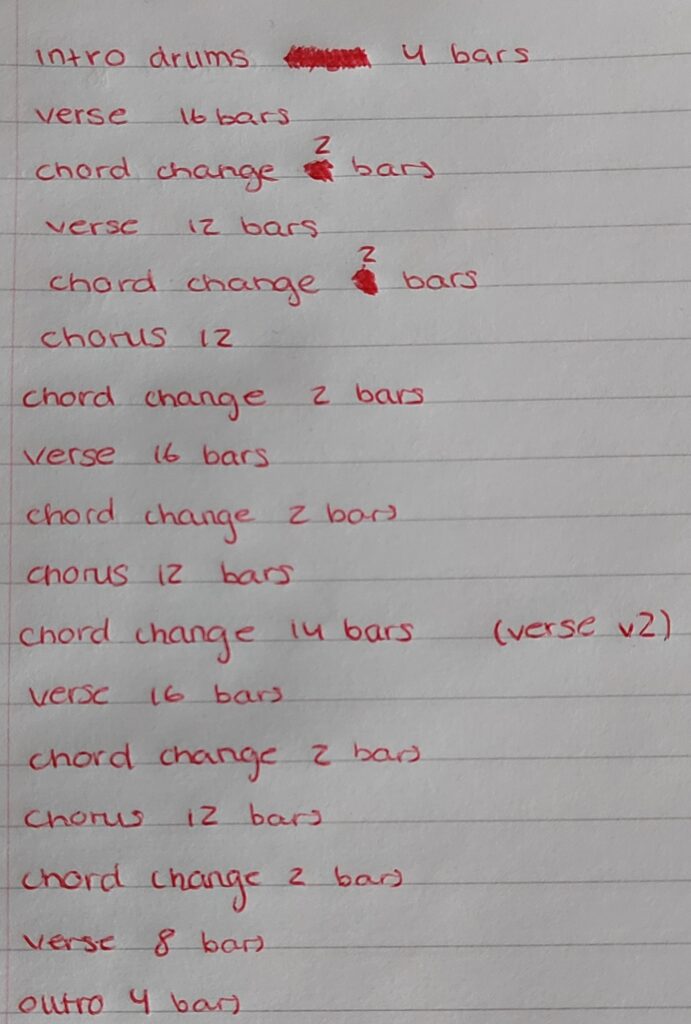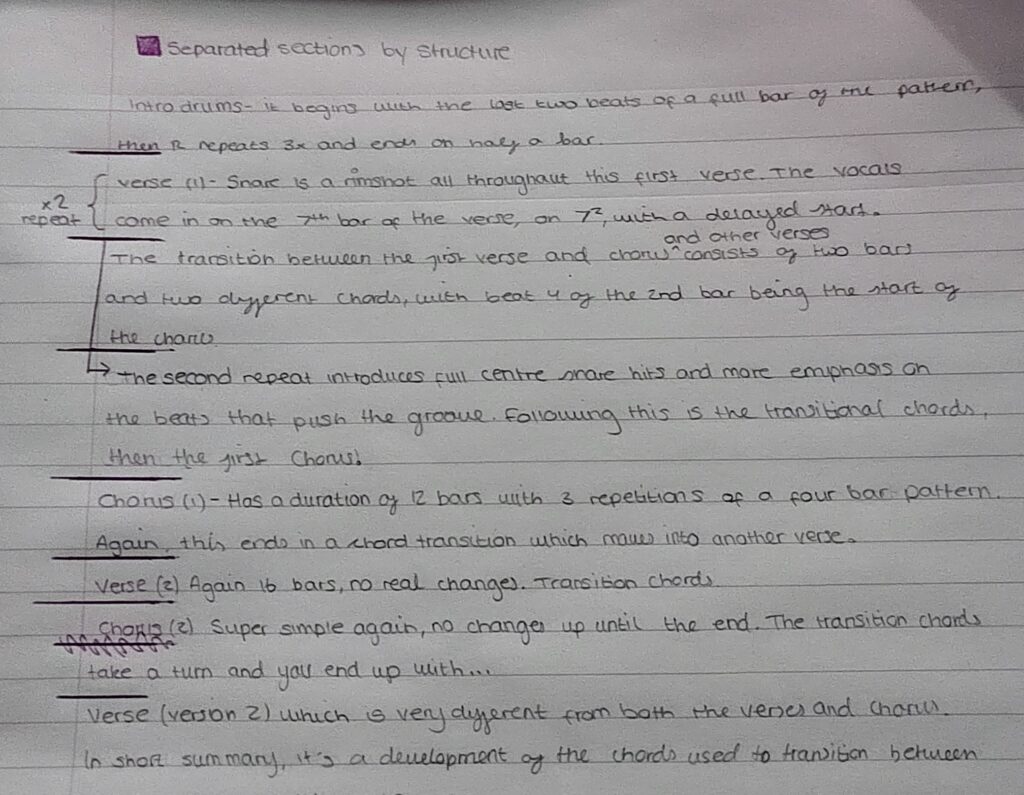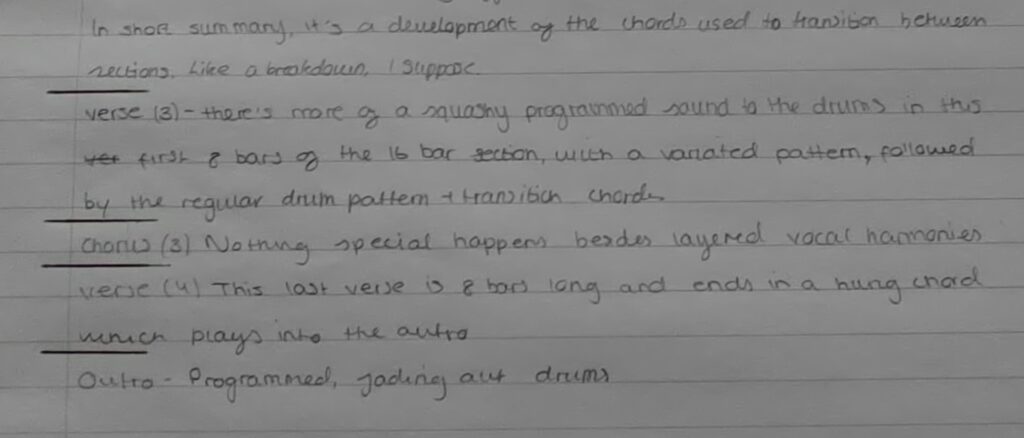INTRO DRUMS
Looking at the drums at the start, I wanted to have a go at programming them since they don’t sound like the rest of the song and have heavy effects on and are merged with other sounds. So by learning from ear, I’ve come up with this:
From there I’ll be continuing on acoustic drums, of which I’ll start of with light snare hits and switch to normal after the first verse and briefly switch back to fading out, low volume programmed drums at the very end. Below is the structure and all changes in drums:
STRUCTURE

This outlines the sections I need to learn and the changes that happen in each part. From this, I’ll extend each section to have information about changes.


Genre, characteristics that it has within that genre
1979 could be classified as alternative / indie rock, which is a broad genre that has a wide range of characteristics.
Here’s a list of characteristics that I found that overlap with both descriptions:
- inclusion of typical lofi sounds, electronic based sounds
- Diverse lyrical themes, often storytelling or exploration of emotions to do with events
- Guitar-driven
- DIY sounding, typically non polished.
1979 includes a few of these characteristics, such as the similarity with sounds associated with lofi in the small keys parts during the chorus, the storytelling in the lyrics and the looping guitar rhythm part that carries the main riff throughout the majority of the song. While it does sound like the band’s sound, it does sound polished and like it was produced to have a warm and clean sound.
The Album & Its Sound
Mellon Collie and The Infinite Sadness poses a sombre mood right off the bat, but variates greatly throughout the rest of the album. Some of the album sticks to this melancholic theme, and other parts come from a place of anger or discontent. The variation in this album may speak true to the band’s personality.
The Story Of 1979
Particularly in 1979, the band states that the producer for that song honed in on the band’s personality. The story of 1979 is as follows, found in an interview from Billy Corgan, who is the band’s lead singer.
The key theme was the end of youth and hopes of the future and life aspirations. It was a musical expression of a written, unedited poem, hence the persistent lyrical patterns, breaks in instrumental parts and syllabic words to go along with certain parts of a melody. In the ‘syllabic’ sense, I mean to say that it’s very punchy with the delivery of each word being deliberate and clear with clear breaks, which go along with beats in the song, in both syncopated patterns and not.
Video Production
The video was an extension of the overarching theme of the song, which is to capture childhood and what that would be like in the time that the song is trying to capture. This is done completely naturally, by using not particularly high-production equipment and not having the cameras as the focus point, since the ‘cast’ were all young teens and young adults.
The direction of it being a documentary more than a music video while filming seems genius for this, as it all feels really natural. Hearing the story behind the video in this video above is exactly how I imagine it was filmed, so it doesn’t feel particularly fake or staged.
Song Production
Flood and Alan Moulder were the two studio producers that worked on the Mellon Collie album, with a lot of personality from 1979 in the mix coming from Flood (otherwise known as Mark Ellis)
Flood is a British producer who has worked with a lot of artists who would come under the genres of pop, rock and alternative rock. He has worked with and been awarded for his work with U2, and has worked with many other well-known bands. He has been active since 1981 and is still active to this day, at 63 years of age. His work with The Smashing Pumpkins, particularly in 1979, gives the song more of a soul and a focus on the story coming from the band members.
The above video backs up the idea of Flood wanting the soul of the whole band, and wanted everything equal for the whole band at that time. The idea of that album being closer to who the band were as people, is special and feels more personal. The band were told to play how they would on stage, so that it doesn’t sound ‘contained’. Songs were recorded as a band rather than individual tracks.
By how it sounds, the process of recording was made fun and comfortable, which may have had some impact on how the album sounded overall.
Brief Melodic Analysis
1979 is in the key Eb major, which is likely why the guitar and bass is tuned to Eb for simplicity. When the guitar, bass and vocals are layered, the song follows the general patten of I^7 to I to IV chord, which causes tension because it never ends in a perfect cadence. I think the intention is to cause tension to allow the song to loop and then move to the chorus which uses that F power chord which feels like the resolving chord even though it’s only the third chord in the scale.
Bibliography
Pumpkins, S. (2021) How flood saw the ‘Real soul’ of the band during recording of Mellon collie, YouTube. Available at: https://youtu.be/qk9uKBazec8 (Accessed: 05 May 2024).
Pumpkins, S. (2013) Smashing pumpkins – the making of ‘1979’ (with commentary), YouTube. Available at: https://youtu.be/FWZx4ZEKFzk (Accessed: 05 May 2024).
Pumpkins, S. (2024) Billy Corgan on the origins of ‘1979’, YouTube. Available at: https://youtu.be/MMODb6A2dO8 (Accessed: 05 May 2024).
Pumpkins, S. (2021) How flood saw the ‘Real soul’ of the band during recording of Mellon collie, YouTube. Available at: https://www.youtube.com/watch?v=qk9uKBazec8 (Accessed: 26 April 2024).
Flood (no date) Beggars music. Available at: https://beggarsmusic.com/composers/flood/ (Accessed: 26 April 2024).
Hooktheory – 1979 by Smashing Pumpkins Chords and melody, Hooktheory. Available at: https://www.hooktheory.com/theorytab/view/smashing-pumpkins/1979 (Accessed: 05 May 2024).